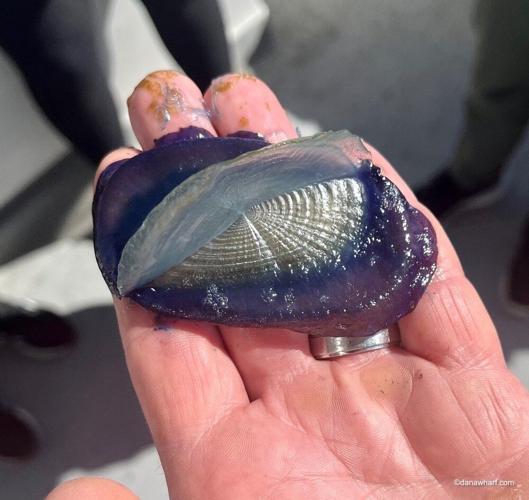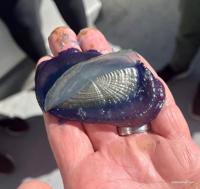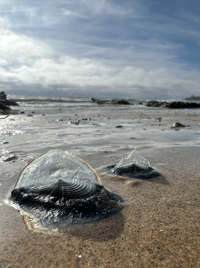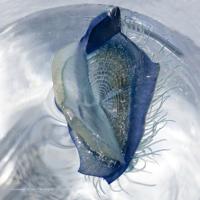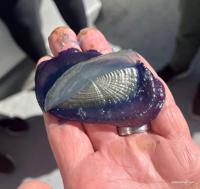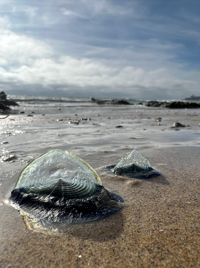Oval, flat, jelly-like creatures—with notable semicircle sails—have been making an appearance on Dana Point and San Clemente shores, prompting beachgoers to wonder what’s causing the mass beaching and whether they’re safe to handle.
Like the name suggests, these By-the-Wind Sailors travel with the wind and currents, Ocean Institute Director of Education Riley Russell explained.
“Since they’re at the mercy of the winds and we’ve been having heavier rainstorms into the summer season … that’s why they’re washing up more,” Russell said. “They can wash up in the hundreds and thousands, even, after stormy winters.”
By-the-Wind Sailors are closely related to jellyfish, but unlike jellies, they are a colony of individual animals that make up the “float,” Russell explained.
“That’s what you see on the surface. It’s the blue disk, and they’re anchored there,” Russell said, adding: “The sail, which is that taller part that comes up, and it’s that semicircle, clear fin-type thing, that’s the part that the wind catches and follows the currents, and that’s how they get the name, By-the-Wind Sailor.”
The sail is made up of chitin, the same substance that crab shells and other hard exoskeletons are made of, Russell said.
Underneath the “float,” a By-the-Wind Sailor has a mouth and tentacles, which it uses to catch the microscopic plankton on which it feeds.
Russell added that “large species of fish that feed on the gelatinous animals out in the ocean” are known to feed on By-the-Wind Sailors, with the Ocean Institute recently observing Mola Mola feeding on the animal.
Though hundreds of the small sea creatures are washing ashore lately, Russell said it likely won’t impact the Molla Molla, as they’ll find another food source to eat.
This isn’t the first time that the Ocean Institute has seen By-the-Wind Sailors, or Velella Velella as they’re also called, come ashore, Russell said.
“We’ve come across them on some of our boat trips, maybe once a year, every other year,” Russell said. “I do know that this year, they did wash up in quite a big amount, and I would imagine that was just the wind direction and currents, because they usually stay offshore a bit more.”
“But once they’ve washed in, there’s nothing they can do,” Russell continued. “They can’t go back out to sea once they’ve washed up on the beaches. But we do see them in big groupings out in the ocean.”
When they wash ashore, By-the-Wind Sailors dry out relatively fast, Russell explained.
“They don’t have any body structure; there’s no bones, no brain, no eyes. It’s just bundles of nerves, and they don’t have any structure to them,” Russell said. “They dry out pretty fast.”

These coastal critters called By-the-Wind Sailors, or Velella Velella, have been washing ashore in Southern California after recent summer storms. Photos: Courtesy of Dana Wharf Sportfishing and Whale Watching (left) and Ocean Institute (right)
Once the animal has washed ashore, By-the-Wind Sailors’ blueish hue fades quickly as it gets bleached from the sun, Russell said. Russell warned that if a beachgoer comes across a Velella Velella on the shore, it’s best not to touch it.
“It’s always safe to say, if you don’t know what something is on the beach, don’t touch it,” Russell said. “Sometimes, animals are on the beach to rest, sometimes they’re on the beach because they’re sick.”
“For this case, these animals cannot help but be washed ashore; they don’t really have control over where they’re going, but it’s always best just to let it be.”
Though Velella Velella do have stinging cells underneath the “float,” Russell explained that the average person is unlikely to feel them.
“We’ve got thicker skin, but I wouldn’t be surprised if people were handling them, their hands are maybe a little irritated afterward,” Russell said.
If someone’s skin is irritated after touching a By-the-Wind Sailor, Russell noted that it’s important to wash their hands with hot water, as hot as they can tolerate, to rinse off the stinging cells.
Russell warns that while it can be fun to “explore and get hands on,” beachgoers should “err on the side of caution, not for themselves, but also for those animals.”
“Let it be and take pictures and ask good questions about what it might be, but it’s always safest not to touch stuff,” Russell continued.
If a beachgoer watches a By-the-Wind Sailor wash ashore, Russell noted they could nudge it back out to sea, but if it’s already on the beach, the animal is likely already dead.
Once the Velella Velella has dried out, it tends to look and feel like plastic, making beachgoers confuse the sea creature for litter.
“As they decompose, like all animals, they are giving nutrients back into the ecosystem on the beach or in the water, wherever they’re decomposing,” Russell said. “So as long as people aren’t picking them up and thinking they need to throw them away … they’ll give back to the environment no matter where they are.”
“If they see it washing up and they can kind of push it back out and that makes them feel better and like they rescued a little By-the-Wind Sailor, then there’s really no harm in that,” Russell continued.
By-the-Wind Sailors are hard to keep in captivity, Russell noted, as they all tend to gather in the corners of tanks and smother each other. Because of this, not a lot of information is known about the sea creature.
“Since it’s a really hard animal to house, there’s a lot not known about them and that could still be discovered,” Russell said. “So, for people who are really interested or if you have kids who are really interested in it, that could be something fun for them as a goal in life, to study more about the By-the-Wind Sailors and learn more about them over the years.”
Russell warned beachgoers to “use caution touching and picking up stuff you don’t know, but otherwise, they’re really fascinating, and they make great pictures.”
“I know when I’ve seen them on a few of my walks, I’ve always tried to snap a few cool photos of them,” Russell continued. “They’re really interesting animals, and they’re really pretty to look at, and I think that’s why they’ve caught so many people’s eyes.”

